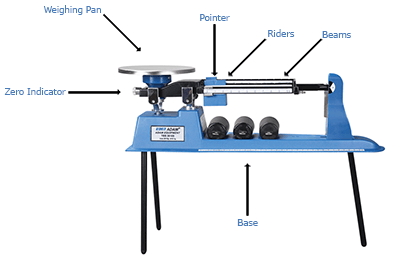
Choosing the right weighing tools for your classroom can be challenging. Educational weighing scales and balances have to be versatile enough to accommodate various levels and curricular, and give you the flexibility to change experiments or add new ones. And of course, all of that has to be done on a tight budget. It can also be difficult to evaluate how complex the product must be, depending on your students’ abilities and learning needs. Should you use the same weighing balance for chemistry and physics classes? Are analytical balance models for college classrooms only, or can AP classes make use of them? This post takes a look at the various scales and balances that can be used for educational classes, and how they can compliment your classrooms.
Basic educational weighing for schools
Standard weighing scales are often required by students who are learning the basics of weighing, such as correct procedure, how to use a scale or a balance, weighing units, how to calibrate a balance, how to weigh the object and record the results. The student would start off knowing little to nothing about weighing, and by the end of the year or semester, should be able to complete basic weighing tasks whether in the lab or at home.
Scales and balances often used in school classrooms include compact scales, mechanical scales and spring balances. All of these scales are simple and easy to use, and are built to withstand accidental damage, they are often small in size and do not have complicated setup procedures. Digital scales in this category often have battery operation, while mechanical balances such as our TBB triple beam balance are fully operational without power mains or battery, eliminating software issues caused by improper use.
An introduction to the mechanical balance
Mechanical balances are simple, effective weighing devices that do not require power mains or batteries to operate. They usually consist of spring scales and triple beam balances.
Triple beam balances are a staple in many classrooms thanks to a sturdy design that allows students to be curious without risking breaking the balance. Being mechanical, there is no electronic component that can be shorted or damaged, and it is highly resistant to spills, overloads and other accidents (still, ensure your students know proper weighing etiquette, and try not to test these limits). Mechanical balances can even help to perform density and specific gravity measurements, ensuring that you get more experiments and longer use out of it.
Take a look at our TBB mechanical balance.

Parts of a Triple Beam Balance
A triple beam balance consists of several parts that need to be configured before use:
- Weighing pan - The area in which an object is placed in order to be weighed.
- Base - The base rests underneath the weighing pan and can usually be customised to fit on a workbench or set up with tripod legs.
- Beams - The three beams on the balance are used to set the level of precision, with each beam working at different increments (1-10grams, 10 grams and 100 grams). When using the triple beam balance, it is recommended that your start with the lowest level of precision e.g 100 gram increments and then work your way down. For example, if your object weighs 327 grams the 100 gram pointer will drop below the fixed mark on the 4th notch (400g), you will then need to move this back to the third notch (300g). This process will then need to be repeated for the 10 gram increments (20g) and then single figure units (7g).
- Riders - The riders are the sliding pointers placed on top of the balance beams to indicate the mass in grams on the pan and beam.
- Pointers - The scale pointer marks the equal point of the object's mass on the scale and mass on the beam
- Zero adustment knob - This is used to manually adjust the triple beam balance to the 'zero' mark (check to ensure that the pointer is at zero before use).
For more information on triple beam balances, please visit the Adam Equipment Youtube channel, where you will find videos on how to calibrate your triple beam balance, zeroing your balance and our comprehensive TBB triple beam balance tutorial.
What are compact balances?
Compact balances are great for basic weighing tasks, whether it’s a beginner’s course in chemistry, cooking or even to weigh small animals. They are usually light in design, easy to transport, and simple to clean. Compact balances require no training and lets students start weighing almost immediately. Most offer both AC and battery power.
Adam’s Dune and CB compact balances are a great value for basic weighing.

Weighing in intermediate science classrooms
Intermediate-level scientific scales offer more features, can weigh smaller items with greater precision, and are meant for more science-based applications. It is assumed that the students already understand the basics of weighing (such as the tare key, units, proper recording, calibration etc...) and are ready to try on more specialised experiments in higher levels of science.
Weighing tasks in both education and research labs might need an accumulation feature (do remember, these balances are made for small compounds and tiny quantities), percentage weighing and parts counting functions, for a greater variety of more complex experiments and tasks.
Education balances that are ideal for this group are most often portable laboratory scale models that may come with a draft shield for field applications in less than ideal conditions. Another valuable feature to look for is a hook for below balance weighing and density measurements.
Our Core and precision balances are packed with features for intermediate weighing tasks.
Advanced weighing procedures at university
High-precision balances are meant for complex weighing tasks performed in laboratories and specialised science classes. They can measure very small quantities and are fine instruments that should be kept in appropriate conditions to ensure their longevity. The Equinox and series of analytical and precision balances are Adam’s solution to advanced weighing problems
An introduction to analytical balances
Analytical balances are made to measure very fine quantities with the most acute precision and accuracy possible. They are meant for laboratory work and they have data communication capabilities compatible with GLP to ensure results are properly recorded. They are often used in fields such as forensics, chemistry and biology and are sensitive to the conditions of their environments. As a result, analytical balances usually come with draft shields to protect the balance.
Our Equinox and Solis series both feature an analytical balance model with a wide range of features, capacities, and readabilities.
What are precision balances?
Precision balances are also meant for small measurements, but they have a higher capacity with readabilities up to three decimal places. Their measurements are not quite as fine as analytical balances, but they are sturdy enough to be taken into the field and other demanding environments while still provide precision and accuracy. Precision balances are more varied, with various platform sizes for messy and bulky samples.
You can compare features on the Equinox and Solis precision balances to see what is right for your classroom or lab.
Choosing the right balance for your grade
Your classroom and the weighing needs outlined in the curriculum will largely dictate which balance or scale is most appropriate. If you teach young children and have basic experiments, something like a mechanical balance or compact balance will do just fine. Take a careful look at the material list, as it will determine what capacity you should get, and how sturdy the balance or scale should be. Readability is important for science classes, as some will only require a small amount of precision (say, to 0.001g) while others will require absolute exactitude. If you mostly work in laboratories with students who use balances a lot, an analytical balance might be worth the extra cost. If you do a lot of field work, consider a more sturdy model or a wider platform. Usually, the more advanced the classes, the more expensive the balance. Wish to learn more about Adam’s education balances and scales? Browse our education page, or feel free to contact us.
We also offer a selection of education resources to help teachers set up classroom science experiments. Please visit our education resource page for more details.

